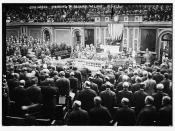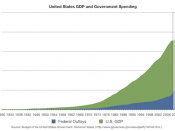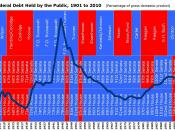One of my better written essays complete with parenthetical references and a biliography. Most sources from internet Excellent, wonderfully written, great use of sources, good use of graphs
"It's time to clean up this mess." Famous last words heard from the mouths of
many different politicians when talking about the national debt and the budget deficit.
Our debt is currently $4.41 trillion and we have a budget deficit of around $300 billion
and growing. Our government now estimates that by the year 2002 the debt will be
$6.507 Trillion. While our politicians talk of balancing the budget , not one of them has
proposed a feasible plan to start paying down the debt.
In the early days of our government debt was considered to be a last resort. In
1790, when Alexander Hamilton, as secretary of the Treasury, made his first report on the
national debt of the United States, he estimated it at close to $70 million.
After
alternately rising and falling, the debt stood at only $4 million, or 21 cents per capita, in
1840. That was the lowest point ever reached by the public debt of the U.S. After 1840 it
rose to a peak, in the last year of the Civil War, of almost $2.68 billion and a per capita
figure of $75.01. The only justification for debt of any significant amount was a war. By
1900 this had been reduced to under $1 Billion. By 1919, the end of World War I, the
debt had climbed to $25.5 Billion. In each of the following years the debt was reduced,
and by 1930 stood at $18.1 Billion. With the collapse of Wall Street in 1929, the country
(debt history: 1850 to 1950)
fell into the Great Depression, which lasted until 1940. At that time the...



Comment
If you balance the budget, including interest payments, then the debt stays constant in money terms and falls in real terms, and relative to the size of a growing economy.
0 out of 0 people found this comment useful.